Strategic Benefits Strategy for Employee Retention and Engagement Long-Term
Last Updated Jun 3, 2025

Jessica thought she nailed it.
After months of sourcing, interviewing, and onboarding a brilliant marketing manager, Rogelio, the offer was accepted. The salary? Competitive. The title? Perfect. The team? Excited.
But six months later, the resignation notice landed on her desk.
When Jessica asked why, Rogelio's answer wasn’t about salary. It was benefits—or rather, the lack of them. No clear path for career growth. No mental health support. No flexibility for school pickups or burnout breaks.
Turns out, her new hire wasn’t alone. More and more employees are weighing benefits as heavily as salary when deciding whether to stay or go.
If you’ve ever watched great talent walk out the door, you know how painful—and expensive—it is.
But the good news? A strong benefits strategy can flip the script.
Discover how to turn your benefits from a retention risk into your strongest retention tool.

Why Benefits are Critical to Employee Retention
Salary matters. But it’s not the whole story.
As revealed in Wellhub's State of Work-Life Wellness 2024 report, 88% of workers say their wellbeing at work is just as important as their paycheck. A competitive salary might get someone in the door, but it’s the benefits package that makes them want to stay.
When benefits are done right, the retention results speak for themselves. Let’s look at the numbers:
- 68% of employees say they’re more likely to stay with an employer that offers health insurance.
- Nearly 60% say a solid retirement plan is a key reason to stick around.
- Over one-third of organizations have already expanded benefits to retain talent.
- 68% of employees say work-life balance influences their decision to stay.
- 55% would remain with an employer that offers flexible work arrangements.
- 98% of HR leaders say their wellbeing program reduces turnover.
- Employees with access to wellness benefits are almost twice as likely to be happy at their company than to those without (61% vs. 36%). The happier employees are, the longer they stay.

And you can draw a straight line from increased retention to better business outcomes:
- It saves serious money. Replacing a single employee can cost up to 200% of their salary. Retention slashes those costs and lets you reinvest in what matters most.
- It drives better performance. Long-term team members know your systems, your culture, and your goals. That familiarity fuels increased efficiency, boosting your company’s output.
- It strengthens team morale. High retention means teammates stick together. That continuity builds trust, improves collaboration.
- It protects institutional knowledge. When people stay, their experience stays with them. You preserve hard-earned insights, processes, and relationships that would otherwise walk out the door—keeping your business smarter and more resilient over time.
The bottom line: people want to feel more than paid. They want to feel supported. When you build a benefits strategy that reflects your team's real priorities, they’ll stick with you for the long haul. And your business will be all the stronger because of it.
Key Benefits to Fuel Retention and Engagement
There are tons of benefits out there, and it can be difficult to even keep up with the newest trends. However, you don’t have to offer every single benefit. A solid benefits package will be tailored to your employees’ needs, likely mixing traditional, modern, customized, and intangible benefits.
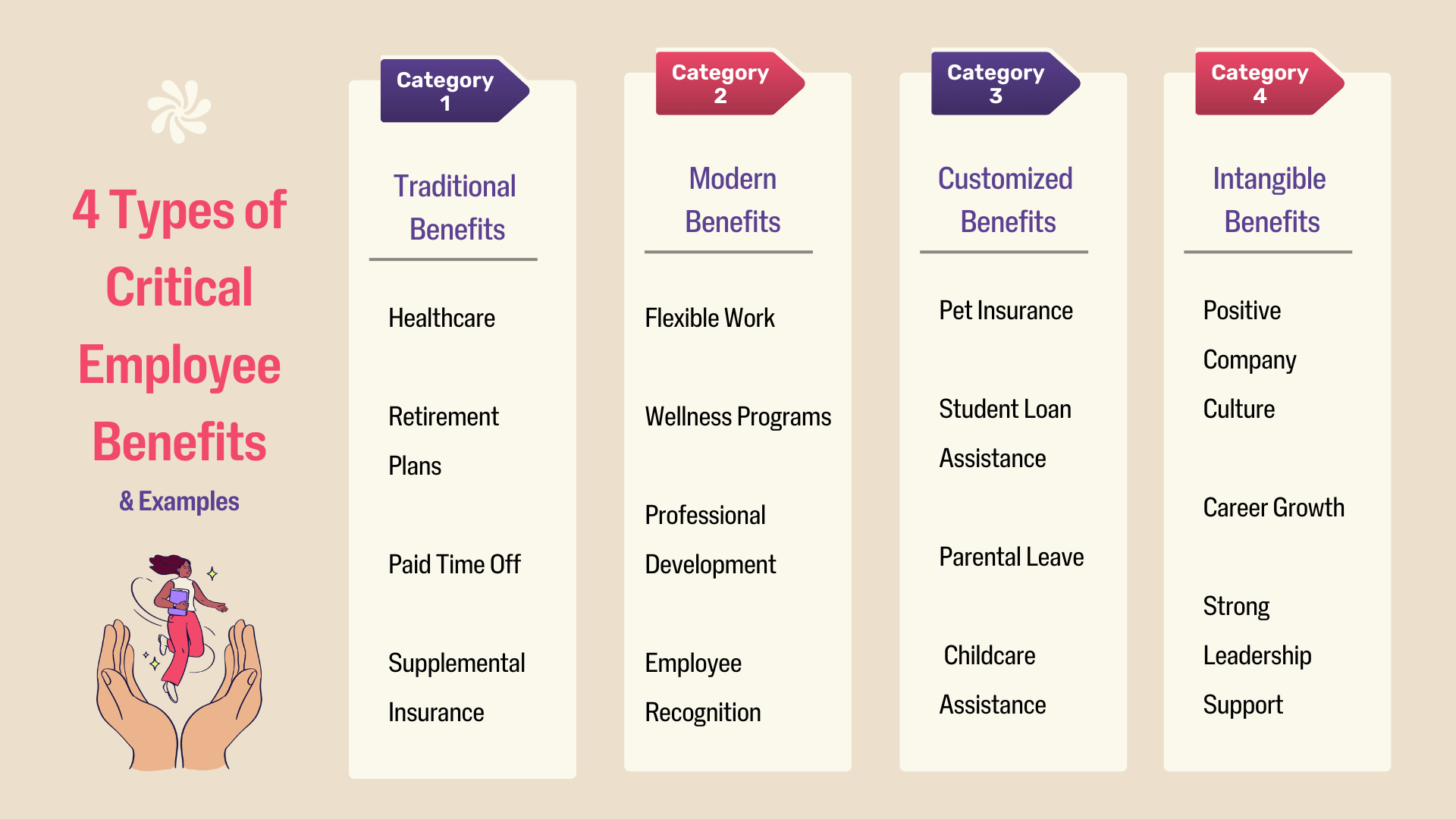
Traditional Benefits
Of course, traditional benefits are a great place to start.
Although they’re not the only kind of benefits available today, they’re still the backbone of any company’s benefits package. This includes healthcare, retirement plans, and other tried-and-true essentials.
Healthcare
Let’s start with the heavyweight champion of benefits: healthcare. And that’s no exaggeration — health insurance is the benefit employees want the most, according to a 2022 SHRM survey. That means investing in your team's fantastic health insurance plan is sure to be appreciated.
Some plans to consider are:
- Medical: Because nobody wants to choose between routine surgery and rent. Comprehensive medical coverage typically covers hospital visits, prescriptions, and preventive care. It shows you care about their wellbeing and not just their work performance.
- Dental: Keeping those pearly whites shining brighter than your company’s future. It provides coverage for routine check-ups, cleanings, and procedures like fillings or crowns.
- Vision: Helping employees see the beautiful opportunities your company offers. Literally. Clear vision means they won’t miss a single detail of that awesome benefits package you’re providing.
Retirement plans
Because you want your employees to dream about their retirement years, a solid retirement plan is a must. In fact, retirement plan benefits are the most sought-after benefits after health insurance, according to a Human Interest survey.
Some of the most common forms of retirement planning benefits are:
- 401(k): This is a tax-advantaged savings plan where employees can contribute a portion of their salary, often with employer matching. 401(k)s are the most popular retirement account among workers, according to the U.S. Census Bureau, so you can’t miss them at your company.
- Pension: The OG of retirement plans, still kicking in some industries. It’s a traditional retirement plan where the employer promises a fixed monthly retirement amount.
Paid time off
A generous paid time off (PTO) policy is a cornerstone of any enticing benefits package. There are no federal requirements for PTO, according to the U.S. Department of Labor, but many companies offer it because of how powerful it is.
To remain competitive, consider offering:
- Vacation: Paid days off for employees to use as they choose, whether for travel, personal relaxation, or personal projects.
- Sick leave: This is PTO but specifically for health-related reasons, allowing your employees to recover without losing income (and without spreading it to the rest of the office!).
- Holidays: Paid time off for nationally recognized holidays gives employees time to celebrate without checking emails.
Insurance
Lastly, insurance is the safety net that shows your employees that their long-term wellbeing is important to you. Because life can be unpredictable, but benefits don’t have to be.
Two you may want to include in your benefits package include:
- Life insurance: Provides a financial award, usually a lump sum or recurring monthly payments, to an employee’s designated beneficiaries in the event of the employee’s death. It shows that you care about their loved ones, too.
- Disability insurance: Offers income protection if an employee becomes unable to work due to illness or injury.
Modern Benefits
Okay, time to move over, traditional perks! Offering modern benefits is important to keep up with the times, especially if you want to attract and retain Millennial and Gen Z talent.
Here’s what you need to know about the benefits that are hot right right now.
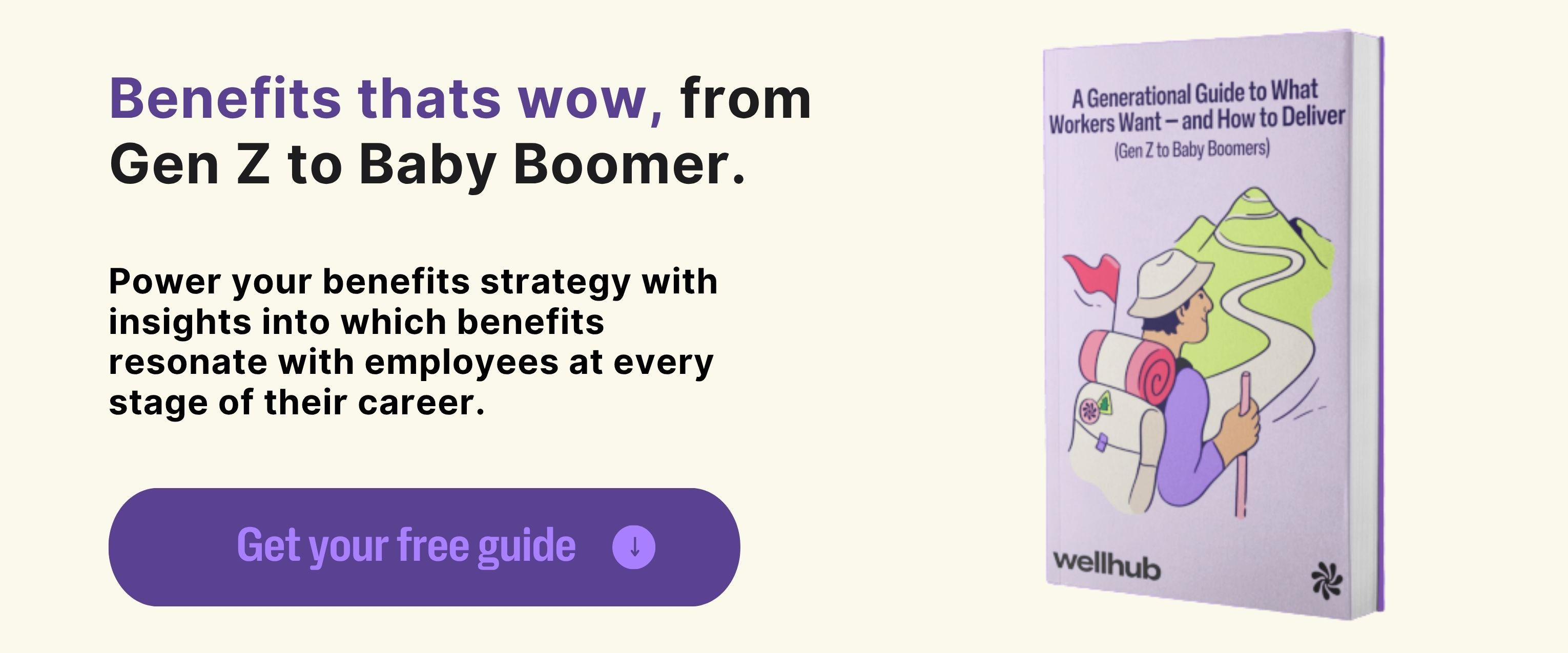
Flexible Work Arrangements
The holy grail of modern benefits: flexible work arrangements. According to Wellhub's State of Work-Life Wellness 2024 report, employees whose current work environment matches their preferred setup are more likely to report that they're thriving. Plus, nine in 10 workers enjoy flexible work arrangements, according to a Deloitte survey.
This is almost like the ice cream cone of benefits — everyone loves it!
- Remote work: Allows employees to work from anywhere with an internet connection, including at home, from a beautiful seaside resort or their grandma’s house.
- Flextime: Gives employees the benefit of setting their own work hours within certain parameters. Perfect for night owls and early birds alike.
- Compressed workweeks: Condenses the standard 40-hour workweek into fewer days, often four 10-hour days instead of five 8-hour days.
Wellness Programs
Let’s talk about keeping your employees in tip-top shape, because a healthy employee is a productive employee. The relationship between employee wellness is significant and well-documented, and you can take advantage of this connection with:
- Gym memberships: Offering free or discounted gym memberships is a great way to motivate employees to get active, helping them to break a sweat without breaking the bank.
- Mental health support: Provides access to mental health services, meditation apps, or stress management workshops.
- Healthy snacks: Consider stocking the office with healthy food and ditching the chips in the vending machine. Keeps hangry employees at bay and energy levels high.
Professional Development Opportunities
Now, for career climbers and knowledge seekers, it’s a good idea to consider professional development benefits. Employees are more engaged and productive when employers support their personal and professional development, according to a Harvard Business Review study. Here’s how:
- Training programs: Consider offering in-house or external courses to improve job-related skills. It keeps your team sharp and up-to-date.
- Conferences: Sending employees to conferences and industry events can be great for networking and learning. It’s the grown-up version of field trips.
- Tuition reimbursement: Your company can help cover the cost of higher education related to an employee’s job, turning your workforce into a brain force.
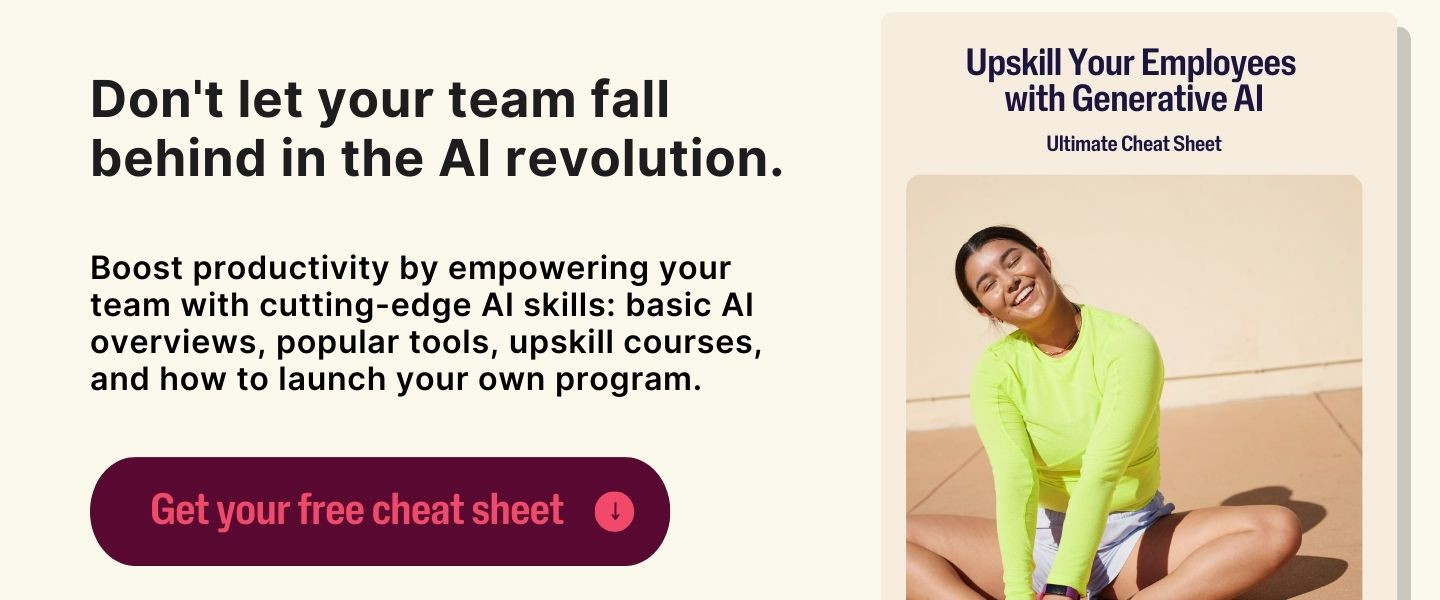
Employee Recognition and Rewards Programs
Lastly, let’s not forget to give credit where credit’s due. Employee recognition and rewards programs are big parts of keeping employees happy. Because who doesn’t love a pat on the back? Here are some ideas:
- Bonuses for exceptional work
- Peer-to-peer recognition platforms
- Awards ceremonies or regular shout-outs (did someone say “Dundies”?)
- Points system redeemable for perks or prizes
Customized Benefits
Let’s face it, one-size-fits-all benefits are so last season. Today’s workforce craves perks that speak to their unique need and lifestyles. Here’s what customized benefits can look like:
- Pet insurance: Fluffy’s pet bills shouldn’t eat into your employee’s savings. Offering pet insurance is just like health insurance but for the four-legged family members.
- Student loan assistance: Help your employees crush that college debt faster than they can say “forbearance.” Offering this benefit can really make you stand out, as only about 5% of workers had access to student loan repayment benefits in 2023, according to the U.S. Bureau of Labor Statistics.
- Parental leave: Paid time off for new parents to bond with their newborn children. It’s like giving parents a golden ticket to focus on what really matters without worrying about missing paychecks.
- Onsite childcare: Employer-provided childcare facilities at or near the workplace can really make a difference. Parents can focus on work while knowing that their children are well taken care of, without spending college tuition prices on daycare.
Intangible Benefits
While tangible perks are great, it’s often the intangible benefits that truly make a workplace shine. These are the elements that transform a job into a career and a workplace into a second home. Here are some of the benefits with the biggest impact:
Positive company culture and values
A set of shared beliefs, attitudes, and practices that define the organization’s performance. A positive culture shapes the organization’s personality and plays a big role in whether an employee stays or leaves.
Opportunities for growth and advancement
Clear career pathways and promotion opportunities within an organization can help motivate employees to stay at a company and improve performance. When your people can see that their future is bright, they’ll put their best foot forward.
Strong leadership and management support
Having a hotline for the decision makers, minus the hold music, can be transformative. When leaders are accessible and supportive, employees feel like their needs and opinions matter.
Crafting a Winning Long-Term Benefits Strategy
Turning your benefits package from a bland soup into a five-star meal isn’t as hard as it may sound. It’s time to put on your chef’s hat and whip up a benefits strategy for engagement that’ll have your employees savoring every bite. Here’s how:
Align Benefits With Company Culture and Values
Think of your company culture as the secret sauce that makes your organization unique. When benefits align with this sauce, magic happens. For example, it would make sense for a tech startup that values innovation to offer cutting-edge health and tech benefits, while a green company could offer eco-friendly commuter perks.
Understand Your Workforce
Each company’s workforce is different, and each benefits package should serve its user base. When employees see their values reflected in their benefits, they’ll be able to take advantage of what matters to them most. But you don’t have to guess what your employees are into. Employee surveys are great for figuring out what your team actually needs. Pair that with some HR analytics, and you’ll be able to hit a home run with your benefits offerings.
Communicate Clearly and Transparently
Having a stellar benefits package and not communicating it well is like having a secret dessert menu and not telling anyone about it. It’s time to shout those benefits from the rooftops — or maybe just the company intranet. Regular benefits seminars, easy-to-read guides, and maybe even a dedicated benefits hotline can turn office jargon into easily digestible snacks.
Regularly Review and Adapt
The only constant in life is change, and benefits should be no exception. Treating your benefits strategy like a living, breathing entity that needs regular check-ups and oil changes. Regular feedback sessions, annual reviews, and staying on top of industry trends can help keep the benefits package fresh and attractive to your employees.
Measuring Success and Making Data-Driven Decisions
Even if you design a benefits package with the best intentions, you won’t know how your team receives it unless you measure the right key performance indicators (KPIs). But with literally hundreds of potential KPIs out there, how do you know where to begin? Here’s how to measure success and make decisions that’ll have employees cheering and CFOs nodding in approval.
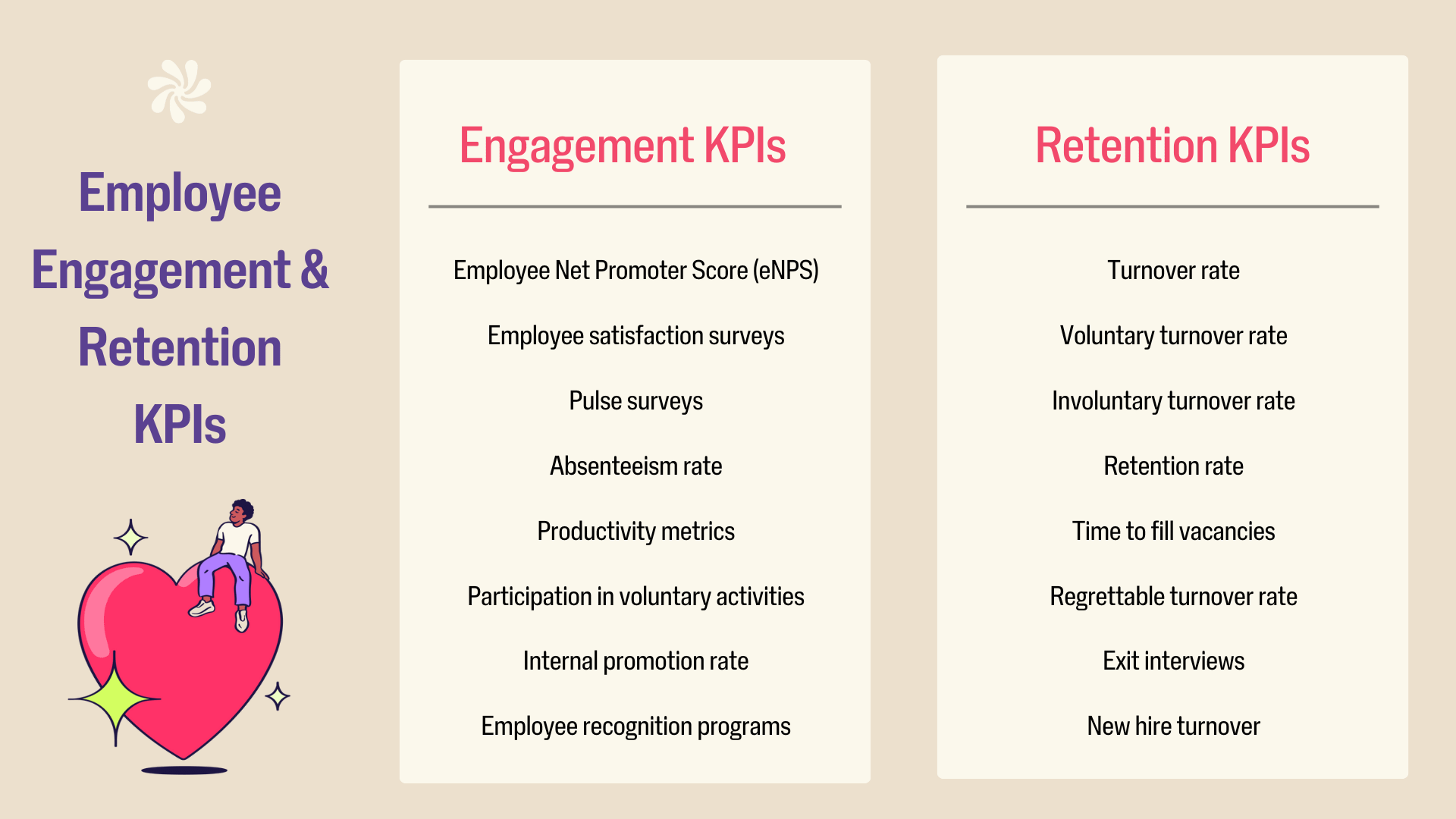
Track Key Metrics
There are a handful of KPIs that all HR professionals could benefit from tracking, no matter their goal. These can help you gauge just how happy and engaged your employees are, which is often a reflection of a company’s culture and benefits. Tracking these long-term will help you spot trends and see how your benefits are doing. Notice an improvement after introducing a new flexible work arrangement? That means your efforts are paying off.
Employee Engagement KPIs
- Employee Net Promoter Score(eNPS): This is your workplace’s Rotten Tomatoes score. Your eNPS measures how likely employees are to recommend their workplace to others. High scores mean employees are spreading the word faster than office gossip. Low scores mean it’s time to get to the bottom of what’s going on.
- Employee satisfaction surveys: These surveys collect feedback on all aspects of the work environment, culture, leadership, and development opportunities. They offer an opportunity to dig deep into what’s going on inside your employees’ minds.
- Pulse surveys: Short, frequent surveys to gauge real-time sentiment on specific topics or initiatives. They’re great for measuring how your employees feel about a specific benefit.
- Absenteeism rate: This is the corporate equivalent of taking attendance in school. It tracks the frequency of unplanned absences for any reason. High rates might mean it’s time to make work more appealing to keep your team engaged.
- Productivity metrics: These asses output, efficiency, and goal attainment, which can be linked to motivation and engagement levels. They show whether employees are working smarter, harder, or just looking busy while planning their next vacation.
- Participation in voluntary activities: See who’s showing up to the party (aka company events) even when it’s not mandatory. High participation rates might mean food is a hit, or maybe employees actually enjoy each other’s company.
- Internal promotion rate: Track who’s climbing the corporate ladder faster than a squirrel up a tree. High internal promotion rates mean opportunities are blooming like flowers in spring.
- Employee recognition programs: Having initiatives that acknowledge and reward employee achievements helps people see that their actions have consequences — like a bonus or an office perk.
Turnover KPIs
Measuring turnover KPIs can help you understand how attractive your company is and how much employees enjoy working there. This will tell you how popular you are in the job market and, once employees have chosen to work with you, how long they’re happy to stick around.
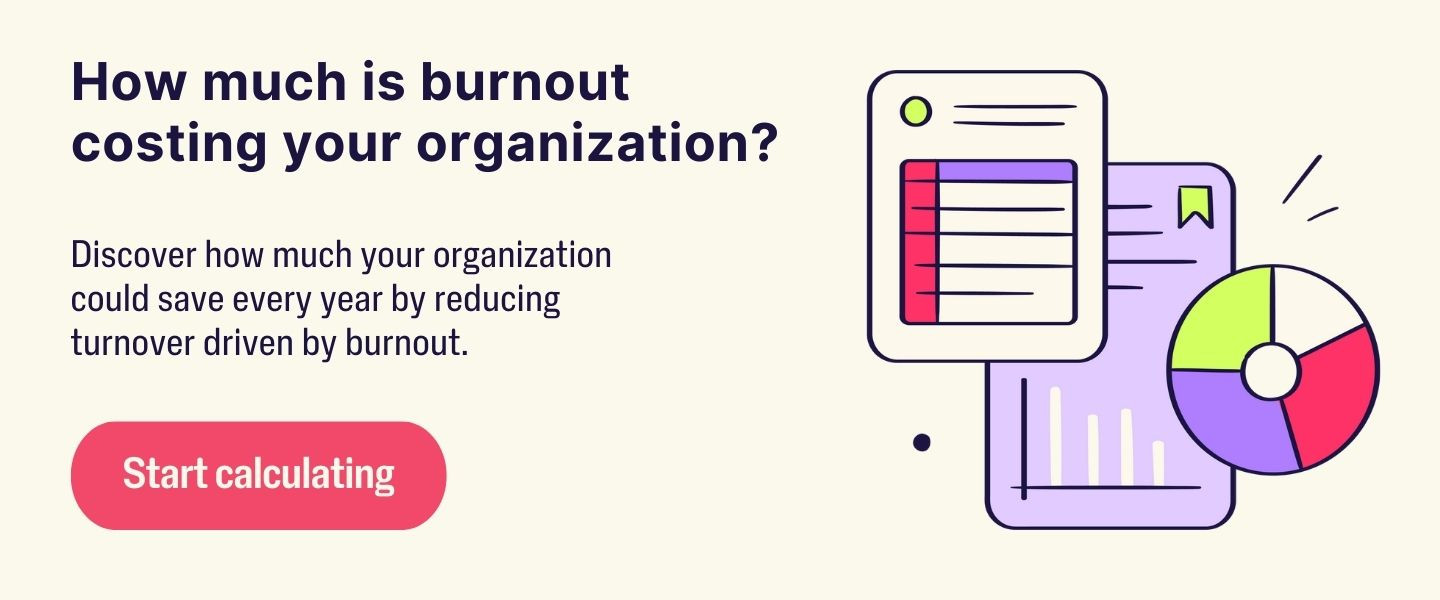
Here are some ideas of turnover KPIs to track:
- Turnover rate: This is the grand total of employee exits calculated as a percentage of the total workforce over a specific period of time. For example, a yearly turnover rate of 2% means that you lose two out of 100 employees per year, on average.
- Voluntary turnover rate: This metric specifically tracks employees who choose to swim to other seas. High rates might mean that employees are finding better opportunities elsewhere.
- Involuntary turnover rate: Tracks terminations or layoffs. A few bad apples here and there are normal. But a high involuntary turnover rate might mean that the company policies, processes, or training aren’t effective at promoting productive employees.
- Retention rate: The flip side of turnover, showing how many employees choose to stick around. High retention rates mean your workplace is a great place to work.
- Time to fill vacancies: Tracks how long it takes to replace a departing employee. Long periods might mean your talent pool is more of a puddle. Or your total compensation package is in dire need of an upgrade.
- Regrettable turnover rate: This one tracks the loss of your workplace MVPs. Losing one or two superstars stings like a bee. But consistently losing your top performers can be lethal for any organization.
- Exit interviews: These feedback sessions are gold mines for understanding why employees are saying “thank you, next” to your company. They can help you understand whether your competitors are offering higher salaries, better benefits, or both.
- New hire turnover: Tracks how many newbies bail before they’ve even figured out how to use the office coffee machine. High rates could mean your job ads aren’t very representative of the actual job or that your onboarding process needs some serious rethinking.
Using data to inform decisions
Now, it’s time to turn those metrics into magic. Tracking metrics is one thing. But any experienced HR professional knows that it’s what you do with them that matters. Even if you’ve never done any HR analytics before, getting some actionable insights from raw data is easier than you might think. Here’s what you can do:
Analyze trends and identify areas for improvement
Think of data trends as breadcrumbs leading to HR solutions. Is that spike in voluntary turnover trying to tell you something? Maybe it’s a sign that your competitors are offering remote work options. Or perhaps that dip in eNPS scores is telling you that the new management style is stressing your employees out.
Connecting the dots between metrics and changes in company operations and benefits offerings can help you paint a crystal-clear picture of what’s happening.
Make adjustments to the benefits program as needed
Once you’re armed with turnover insights, it’s time to fine-tune your benefits program. Is the gym membership perk collecting more dust than a treadmill after the New Year’s resolutions rush? Maybe it’s time to swap it for a mental health app subscription that employees will actually use.
Or if exit interviews are consistently mentioning lack of growth opportunities, it might be time to beef up those professional development budgets. Remember that a benefits program should be as flexible as a yoga instructor — ready to bend and stretch to meet changing needs.
Quick Wins: Concrete Steps HR Can Take to Use Benefits for Improved Retention
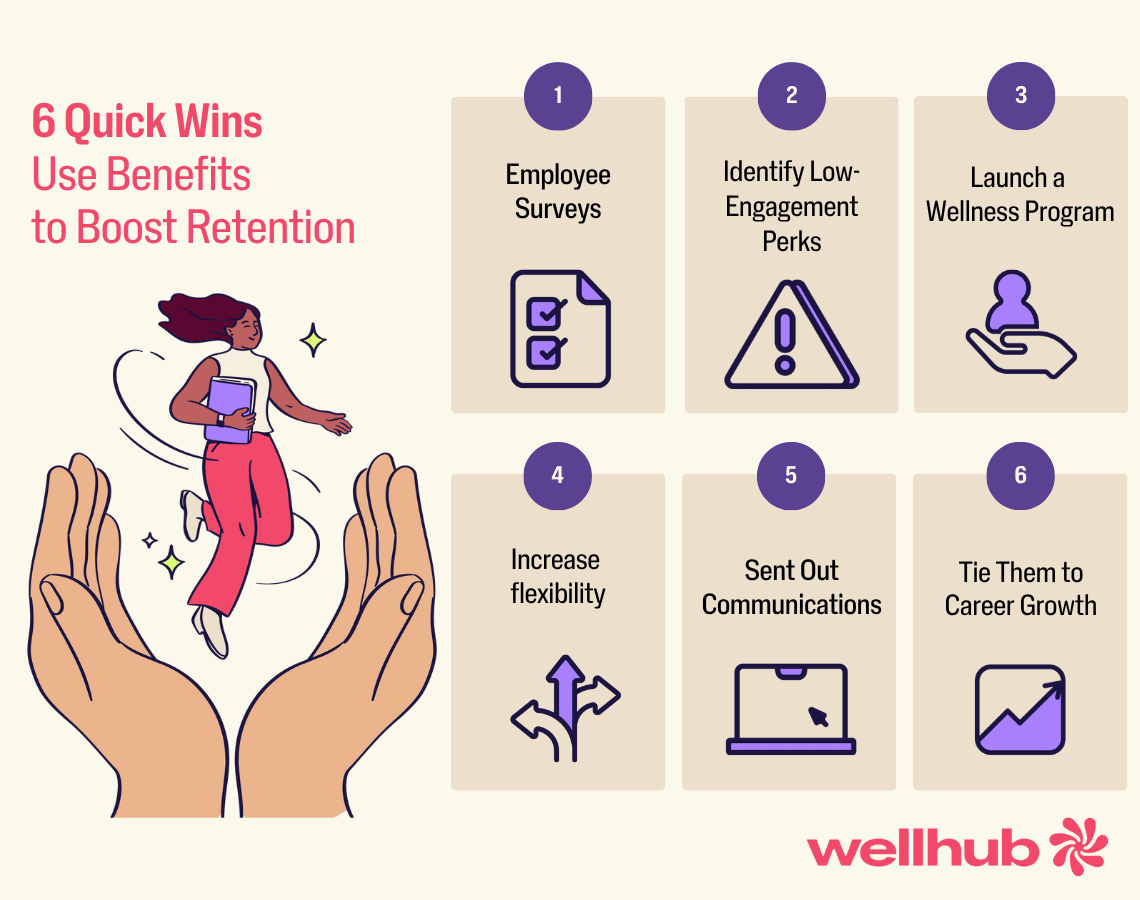
- Survey Employees to Pinpoint What Matters Most
The Tactic: Run a short, anonymous pulse survey to ask employees which benefits they use, which they want, and which they never touch.
How to Take Action: Use tools like Google Forms, Culture Amp, or your HRIS platform. Ask ranked-choice questions to prioritize needs.
Why it Works: Targeted benefits feel personal—boosting perceived value and satisfaction.
- Audit and Eliminate Low-Engagement Perks
The Tactic: Review usage data on existing perks and phase out the ones employees don’t value.
How to Take Action: Look at enrollment rates, attendance, or redemption figures—anything that shows ROI.
Why it Works: You can reinvest in high-impact offerings instead of wasting budget on unused perks.
- Introduce a Wellness Program
The Tactic: Add or expand access to mental wellness support, fitness programs, or flexible wellbeing stipends.
How to Take Action: Partner with a provider like Wellhub for instant access to 14,000+ gyms, apps, and coaches.
Why it Works: 98% of HR leaders say wellness programs reduce turnover, and 99% say they boost productivity.
- Offer Lifestyle Flexibility (Without Overhauling Policy)
The Tactic: Pilot flexible work hours or compressed workweeks in one department or role.
How to Take Action: Start with roles that don’t require fixed coverage. Set clear boundaries and expectations.
Why it Works: Flexibility is consistently ranked a top priority—offering it can dramatically improve retention without major cost
- Highlight Benefits in Onboarding and Ongoing Comms
The Tactic: Create a monthly “benefits spotlight” email or Slack post to remind people what’s available.
How to Take Action: Include usage tips, success stories, and links to enroll or book.
Why it WorksL More than half of employees aren’t even aware of all the benefits available to them.
6. Tie Benefits to Career Growth
The Tactic: Expand or clarify benefits related to professional development, like stipends for courses or certifications.
How to Take Action: Launch a simple application process for requesting learning resources. Promote it at performance review time.
Why it Works: Employees are more likely to stay when they see a future for themselves at your company.
Want to move fast? Start with two of these tactics this quarter. You'll send a strong message: “We’re listening. And we’re building a benefits strategy that reflects what matters to you.” That’s the kind of message that makes people stay.
Overcoming Common Challenges Faced When Employee Benefit Expansion
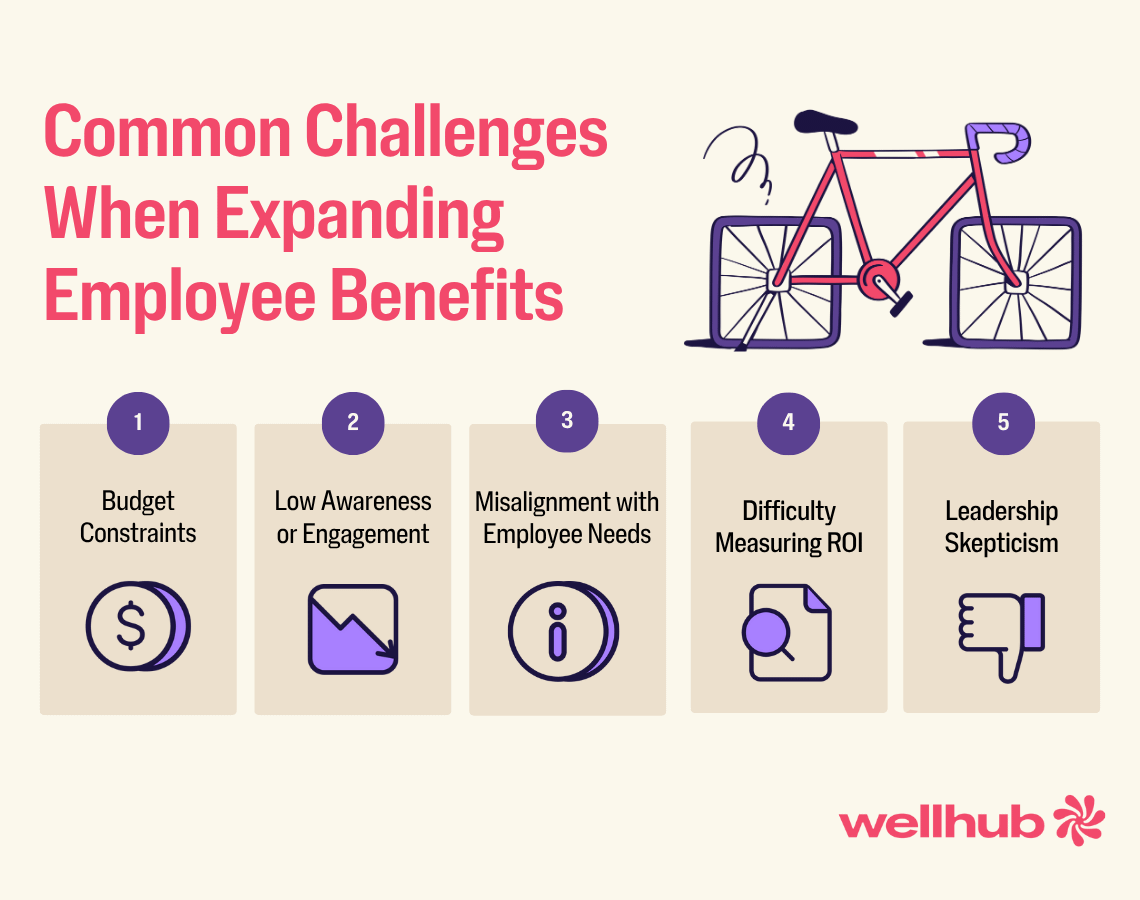
Challenge 1: Budget Constraints
You want to offer more, but your CFO wants to spend less.
How to overcome it:
- Focus on ROI, not just cost. Show how high-impact, low-cost benefits like wellness programs deliver returns through improved productivity, fewer sick days, and reduced turnover. This is why 56% of companies get $2 back for every $1 they invest in a wellness program.
- Start small. You don’t need a six-figure strategy to get started. Pilot a flexible benefits stipend or launch a low-cost digital wellness solution and scale from there.
- Cut underused perks. Audit and reallocate funds from unused programs to benefits employees actually value.
Challenge 2: Low Employee Awareness or Engagement
You’re offering great benefits—but nobody’s using them.
How to overcome it:
- Market your benefits like you would a product. Use email campaigns, Slack reminders, lunch-and-learns, and 1:1 manager conversations to raise visibility.
- Tell real stories. Highlight how employees are using perks—like a teammate who started therapy or hit a health goal—to make benefits feel relatable and relevant.
- Onboardwith impact. Don’t let new hires find out about perks in a dusty PDF. Build benefits into onboarding—and include a live walk-through or Q&A.
Challenge 3: Misalignment With Employee Needs
Benefits don’t land when they’re not what your workforce actually wants.
How to overcome it:
- Ask first. Run pulse surveys or focus groups to identify what matters most. Your data is your compass.
- Segment your approach. One-size-fits-all benefits fall flat. Try tiered, flexible, or pick-your-perks systems to give employees control.
- Update regularly. Needs evolve—especially with multigenerational teams. Review your offerings at least annually to ensure they still fit.
Challenge 4: Difficulty Measuring ROI
It’s tough to show leadership that benefits are more than a feel-good investment.
How to overcome it:
- Track the right metrics. Pair qualitative feedback (satisfaction, perceived support) with quantitative KPIs (retention rates, sick days, benefit utilization).
- Use provider dashboards. Many vendors—including Wellhub—offer built-in analytics to show engagement, usage, and outcomes.
- Connect benefits to business goals. Frame data in terms your C-suite cares about: cost savings, retention trends, and productivity gains.
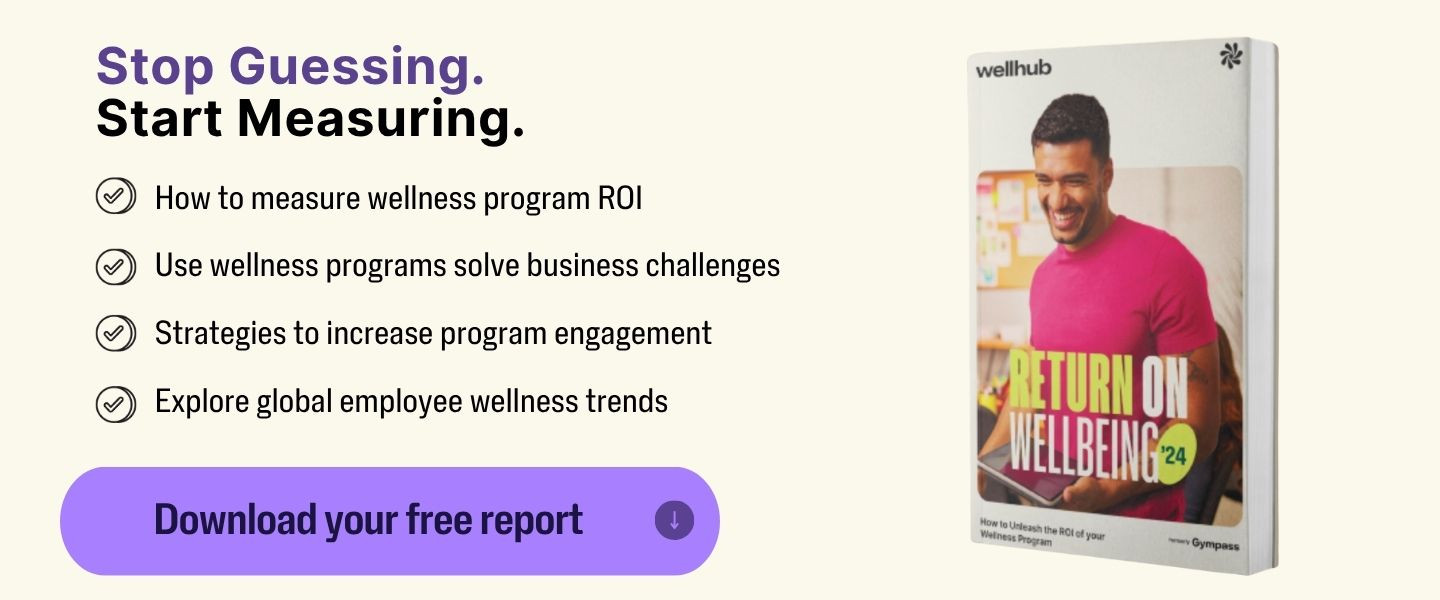
Challenge 5: Getting Leadership Buy-In
Some executives may see benefits as a “perk” instead of a business driver.
How to overcome it:
- Lead with the business case. Show them how replacing an employee can cost up to 200% of their salary. Retention-focused benefits are cost control.
- Share employee voice. Present direct quotes or survey stats that show what your people value and expect.
- Highlight competitor benchmarks. Show how peer organizations are using benefits to gain a hiring and retention edge
Every HR leader trying to build a benefits strategy that drives retention is going to hit a speed bump. What matters most is showing up with data, listening deeply, and adjusting fast. That’s how you turn good intentions into real retention wins.
Build a Benefits Strategy That Actually Works
A winning benefits strategy does more than check boxes. It connects with your employees, reflects your company values, and drives real results. When you layer in holistic wellness initiatives, you create a culture that supports retention, engagement, and satisfaction.
Wellhub’s Return on Wellbeing 2024 report shows that 95% of companies tracking ROI see positive returns on their wellbeing programs—with over half seeing more than 100% returns.
Ready to turn your benefits strategy into your biggest retention tool? Speak with a Wellhub Wellbeing Specialist and start building a program your employees won’t want to leave.

Company healthcare costs drop by up to 35% with Wellhub*
See how we can help you reduce your healthcare spending.
[*] Based on proprietary research comparing healthcare costs of active Wellhub users to non-users.
You Might Also Like:
- How to Improve Employee Retention
- 10 Employee Retention Metrics You Should Be Tracking
- 5 Tips for Refining Your Employee Retention Strategy
References:
- Dyerly, R. (2025, January 21). The myth of replaceability: preparing for the loss of key employees. SHRM. https://www.shrm.org/executive-network/insights/myth-replaceability-preparing-loss-key-employees
- Gagliardi, N., Grinza, E., & Rycx, F. (2022). Workers’ tenure and firm productivity: New evidence from matched employer‐employee panel data. Industrial Relations a Journal of Economy and Society, 62(1), 3–33. https://doi.org/10.1111/irel.12309
- Human Interest. 401(k) plans are the most-wanted benefit after health insurance. (n.d.). https://humaninterest.com/learn/guides/retirement-roadblocks/
- Bureau, U. C. (2022, August 31). New Data Reveal Inequality in Retirement Account Ownership. Census.gov. https://www.census.gov/library/stories/2022/08/who-has-retirement-accounts.html
- U.S. Bureau of Labor Statistics. Flexible work schedule and student loan repayment benefits : U.S. Bureau of Labor Statistics. (2023, September 21). https://www.bls.gov/ebs/factsheets/flexible-work-schedule-and-student-loan-repayment.htm
- Keswin, E. (2022, April 5). 3 Ways to Boost Retention Through Professional Development. Harvard Business Review. https://hbr.org/2022/04/3-ways-to-boost-retention-through-professional-development
- DOL. Paid Leave. (n.d.). https://www.dol.gov/agencies/wb/featured-paid-leave
- SHRM. (2024). Employee Benefits Survey. Shrm.org. https://www.shrm.org/topics-tools/research/employee-benefits-survey?utm_source=newsletter&utm_medium=email&utm_campaign=newsletter_axioscommunicators&stream=business
- SHRM. (2024, November 22). Future of talent Retention: Understanding why employees leave and why they stay. SHRM. https://www.shrm.org/executive-network/insights/future-of-talent-retention-report-why-employees-leave
- Tyler, K. (2022, January 8). What Employees Want. Www.shrm.org. https://www.shrm.org/topics-tools/news/all-things-work/employees-want
- Deloitte United States. Workplace Flexibility Survey. (n.d.). https://www2.deloitte.com/us/en/pages/about-deloitte/articles/workplace-flexibility-survey.html
- Wellhub. (2023, October 18). The State of Work-Life Wellness 2024. https://wellhub.com/en-us/resources/research/work-life-wellness-report-2 024/
- Wellhub (2024, May 16). Return on Wellbeing 2024. https://wellhub.com/en-us/resources/research/return-on-wellbeing-2024/
- Zhenjing, G., Chupradit, S., Ku, K. Y., Nassani, A. A., & Haffar, M. (2022). Impact of employees’ workplace environment on employees’ performance: A multi-mediation model. Frontiers in Public Health, 10(890400). NCBI. https://www.ncbi.nlm.nih.gov/pmc/articles/PMC9136218/
Category
Share

The Wellhub Editorial Team empowers HR leaders to support worker wellbeing. Our original research, trend analyses, and helpful how-tos provide the tools they need to improve workforce wellness in today's fast-shifting professional landscape.
Subscribe
Our weekly newsletter is your source of education and inspiration to help you create a corporate wellness program that actually matters.
Subscribe
Our weekly newsletter is your source of education and inspiration to help you create a corporate wellness program that actually matters.
You May Also Like

FSA vs. HSA Strategy for HR Leaders | Wellhub
Compare FSA vs HSA rules, tax advantages, eligibility, and rollover differences to help employees choose the right account and avoid costly compliance issues.

Employee Wellness Programs: Key Components for Success | Wellhub
Transform your workplace wellness strategy by integrating physical, mental, financial, and social wellbeing into a comprehensive wellness program that works

Benefits Strategy Roadmap: Pull and Retain Top Talent | Wellhub
Support wellbeing, reduce turnover, and maximize ROI with a benefits strategy built for today’s workforce—not yesterday’s spreadsheet.